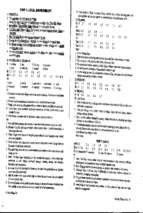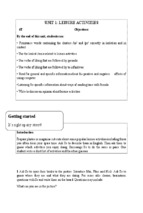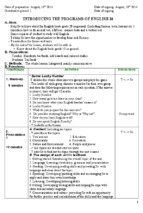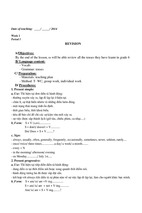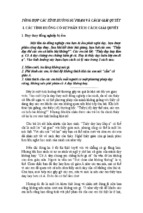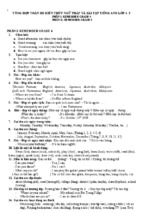Lesson plan English 5
Duy Ninh Primary school
Preparing date: August 20th, 2016
Teaching date: Monday Morning, August 22nd, 2016 (5AT4, 5CT5)
Tuesday Morning, August 23rd, 2016 (5BT1)
WEEK 1 – PERIOD 1
UNIT 1: WHAT’S YOUR ADDRESS?
Lesson 1: Part 1-2-3
I. Objectives
- By the end of this unit, pupils can use the phrases related to the topics
Addresses and Hometown.
- Pupils can ask and answer questions about one’s address, using What’s
your address? It’s ...
- Pupils can develop listening and speaking skills.
II. Procedures
*Warm up: Slap the board
A. Presentation
1. Look, listen and repeat
Step 1: Point each character and elicit pupils’ answers: Who’s this? What’s
his/her name? Where is he/she from? Where is she/he living now? Get pupils
to repeat the new word a few times.
Step 2: Playing the recording all the way through for the class to listen.
Step 3: Play it again for pupils to repeat line by line.
B. Practice
2. Point and say
Step 1: Revise numbers 10 to 100 with the class.
Step 2: Point to each picture and ask the question What’s your address? for
pupils to answer.
Step 3: Have pupils practice asking and answering in pairs.
Step 4: Invite one or two pairs to speak to check.
1
Lesson plan English 5
Duy Ninh Primary school
2
Lesson plan English 5
Duy Ninh Primary school
C. Production
3. Let’s talk
Step 1: Get pupils to work in groups of four/five to ask each other’s
addresses.
Step 2: Set a time limit for the class to practice.
Step 3: Invite a few pupils to repeat their interviews to the class.
D. Application
- Learn by heart the new words.
- Prepare the next period: Unit 1: Lesson 1: Part 4,5,6
3
Lesson plan English 5
Duy Ninh Primary school
Preparing date: August 20th, 2016
Teaching date: Monday Afternoon, August 22nd, 2016 (5AT2)
Wednesday Morning, August 24th, 2016 (5BT3)
Thursday Morning, August 25th, 2016 (5CT3)
WEEK 1 – PERIOD 2
UNIT 1: WHAT’S YOUR ADDRESS?
Lesson 1: Part 4-5-6
I. Objectives
- By the end of this unit, pupils can use the phrases related to the topics
Addresses and Hometown.
- Pupils can ask and answer questions about one’s address, using What’s
your address? It’s ...
- Pupils can develop speaking, listening and reading skills.
II. Procedures
*Warm up: Revising the story in Activity 1
A. Presentation
4. Listen and complete
Step 1: Playing the recording all the way through for pupils to listen.
Step 2: Play it again for them to do the task.
Step 3: Get them to compare their answers.
Step 4: Play the recording again to confirm the answers.
Key: 1. 208 2. 321
3. White Street
4. The second floor
B. Practice
5. Read and complete
Step 1: Give pupils a few seconds to read the sentences.
Step 2: Set a time limit for pupils to do the task independently.
Step 3: Get pupils to compare their answers in pair before checking as a
class.
Key: 1. from
2 lives 3 address
4 Street
4
Lesson plan English 5
Duy Ninh Primary school
C. Production
6. Let’s sing
Step 1: Have pupils read the lyrics and teach the unfamiliar words.
Step 2: Play the recording all the way through for pupils to listen.
Step 3: Play it again for pupils to repeat line by line.
Step 4: Have pupils practice singing and doing action in groups.
Step 5: Invite a group to sing the song and do actions.
D. Application
- Learn by heart the sing.
- Prepare the next period: Unit 1: Lesson 2: Part 1,2,3.
5
Lesson plan English 5
Duy Ninh Primary school
Preparing date: August 21st, 2016
Teaching date: Tuesday Morning, August 23rd, 2016 (5AT4)
Wednesday Morning, August 24th, 2016 (5BT4)
Thursday Morning, August 25th, 2016 (5CT4)
WEEK 1 – PERIOD 3
UNIT 1: WHAT’S YOUR ADDRESS?
Lesson 2: Part 1-2-3
I. Objectives
- By the end of this unit, pupils can use the phrases related to the topics
Addresses and Hometown.
- Pupils can ask and answer questions about what a village/town/city is like,
using What’s the … like? It’s …
- Pupils can develop speaking and listening skills.
II. Procedures
*Warm up: Have the class sing The wheels on the bus.
A. Presentation
1. Look, listen and repeat
Step 1: Point at each picture to elicit pupils’ answers: What’s his name?
Who’s he talking with? Get pupils to repeat the new word a few times.
Step 2: Playing the recording all the way through for the class to listen.
Step 3: Play it again for pupils to repeat the lines in the bubbles.
B. Practice
2. Point and say
Step 1: Revise the adjectives big, far, large and small and teach the new
ones: busy, quiet, crowded, pretty.
Step 2: Point to each picture and ask the question What’s the … like? for
pupils to answer.
Step 3: Have pupils practice asking and answering in pairs.
Step 4: Invite one or two pairs to speak to check.
6
Lesson plan English 5
Duy Ninh Primary school
C. Production
3. Let’s talk
Step 1: Set a time limit for the class to practice.
Step 2: Invite one or two pairs to act out their conversations.
D. Application
- Prepare the next period: Unit 1: Lesson 2: Part 4,5,6
7
Lesson plan English 5
Duy Ninh Primary school
Preparing date: August 22nd, 2016
Teaching date: Wednesday Afternoon, August 24th, 2016 (5AT1)
Thursday Morning, August 25th, 2016 (5BT1)
Friday Afternoon, August 26th, 2016 (5CT3)
WEEK 1 – PERIOD 4
UNIT 1: WHAT’S YOUR ADDRESS?
Lesson 2: Part 4-5-6
I. Objectives
- By the end of this unit, pupils can use the phrases related to the topics
Addresses and Hometown.
- Pupils can develop listening and writing skills.
II. Procedures
*Warm up: Play Bingo
A. Presentation
4. Listen and circle a or b
Step 1: Ask pupils to read the sentences and guess the correct answers.
Step 2: Playing the recording all the way through for pupils to listen.
Step 3: Play it again for them to do the task.
Step 4: Get them to compare their answers.
Key: 1a 2b 3b 4a
B. Practice
5. Write about you
Step 1: Have pupils read the questions and check their understanding.
Step 2: Set a time limit for them to do the task.
Step 3: Get them to swap and read their writing.
Step 4: Invite one or two pupils to read their answers aloud and give
feedback.
8
Lesson plan English 5
Duy Ninh Primary school
C. Production
6. Let’s play
Step 1: Compare the two pictures.
Step 2: Find out the five details which are different.
Key: Picture b is different from Picture a:
- There is one more car in the road.
- There is a woman in front of the yellow building.
- The sign next to the yellow building is blue, and it reads BUS STOP.
- There is no logo of pills on the pharmacy.
- There is a boy behind the father and daughter.
D. Application
- Learn by heart the new words.
- Prepare the next period: Unit 1: Lesson 3: Part 1,2,3
9
Lesson plan English 5
Duy Ninh Primary school
Preparing date: September 3rd, 2016
Teaching date: Monday Morning, September 5th, 2016 (5AT4, 5CT5)
Tuesday Morning, September 6th, 2016 (5BT1)
WEEK 2 – PERIOD 5
UNIT 1: WHAT’S YOUR ADDRESS?
Lesson 3: Part 1-2-3
I. Objectives
- By the end of this unit, pupils can use the phrases related to the topics
Addresses and Hometown.
- Pupils can pronounce two-syllable words with the stress on the first
syllable: ‘city, ‘village, ‘mountain, and ‘tower
- Pupils can develop listening and speaking skills.
II. Procedures
*Warm up: Invite a few pupils to read their answers to Activity 5.
A. Presentation
1. Listen and repeat
Step 1: Explain that in a word with more than one syllable, one of the
syllables is usually said with more emphasis than the rest.
Step 2: Playing the recording all the way through for pupils to listen.
Step 3: Play it again for them to repeat all the words and sentences twice.
B. Practice
2. Listen and circle a or b. Then say the sentences.
Step 1: Ask pupils to read the sentences in silent.
Step 2: Playing the recording all the way through for pupils to listen.
Step 3: Play it again for them to do the task.
Step 4: Get them to compare their answers.
Key: 1b 2a 3a
10
Lesson plan English 5
Duy Ninh Primary school
C. Production
3. Let’s chant
Step 1: Have pupils read the chant.
Step 2: Play the recording all the way through for pupils to listen.
Step 3: Play it again for pupils to repeat line by line.
Step 4: Have pupils practice chanting and doing action in groups.
Step 5: Invite two or three groups to say the chant and do actions.
D. Application
- Learn by heart the new words.
- Prepare the next period: Unit 1: Lesson 1: Part 4,5,6,7
11
Lesson plan English 5
Duy Ninh Primary school
Preparing date: September 3rd, 2016
Teaching date: Monday Afternoon, September 5th, 2016 (5AT2)
Wednesday Morning, September 7th, 2016 (5BT3)
Thursday Morning, September 8th, 2016 (5CT3)
WEEK 2 – PERIOD 6
UNIT 1: WHAT’S YOUR ADDRESS?
Lesson 3: Part 4-5-6-7
I. Objectives
- By the end of this unit, pupils can use the phrases related to the topics
Addresses and Hometown.
- Pupils can ask and answer questions about one’s address and about what a
village/town/city is like.
- Pupils can develop pupils’ reading and writing skills.
II. Procedures
*Warm up: Have the class say the chant Where do you live?
A. Presentation
1. Read and tick Yes or No
Step 1: Get pupils to read the sentence and underline the key words/phrases.
Step 2: Set a time limit for pupils to do the task independently.
Step 3: Have them compare their answers.
Key: 1N 2Y 3N 4Y 5Y
B. Practice
5. Write about your friend
Step 1: Give pupils time to read the questions.
Step 2: Set s time limit for them to do the task independently.
Step 3: Get them to swap and read their writing in pairs.
Step 4: Invite two or three pupils to read their answers aloud
12
Lesson plan English 5
Duy Ninh Primary school
C. Production
6. Project
Step 1: Discuss the house they are going to draw, and its address.
Step 2: Set a time limit for them to do the task.
Step 3: Invite a few groups to present their drawing to the class and talk
about them.
7. Colour the stars
Step 1: Have the class read the statements and check their comprehension.
Step 2: Give them time to colour the stars and invite a few pupils to read the
statement aloud.
D. Application
- Learn by heart the new words.
- Prepare the next period: Unit 2: Lesson 1: Part 1,2,3
13
Lesson plan English 5
Duy Ninh Primary school
Preparing date: September 4th, 2016
Teaching date: Tuesday Morning, September 6th, 2016 (5AT4)
Wednesday Morning, September 7th, 2016 (5BT4)
Thursday Morning, September 8th, 2016 (5CT4)
WEEK 2 – PERIOD 7
UNIT 2: I always get up early. How about you?
Lesson 1: Part 1-2-3
I. Objectives
- By the end of this unit, pupils can use words and phrases related to the
topic Daily routines.
- Pupils can ask and answer questions about someone’s daily routine, using
What do you do….? I always/ usually/ often/ sometimes …
- Pupils can develop reading, listening and speaking skills.
II. Procedures
*Warm up: Have the class talk about their houses.
A. Presentation
1. Look, listen and repeat
Step 1: Point each character and elicit pupils’ answers: Who’s this? What’s
he doing? What does he do in the morning? Get pupils to repeat the new
word a few times.
Step 2: Playing the recording all the way through for the class to listen.
Step 3: Play it again for pupils to repeat line by line.
Step 4: Check their understanding of the story.
B. Practice
2. Point and say
Step 1: Have pupils look at the pictures.
Step 2: Teach them how to read the words and phrases under each picture.
Step 3: Have pupils practice asking and answering in pairs.
14
Lesson plan English 5
Duy Ninh Primary school
Step 4: Invite one or two pairs to speak to check.
C. Production
3. Let’s talk
Step 1: Get pupils to work in pairs by asking and answering questions about
someone’s daily routines.
Step 2: Set a time limit for the class to practice.
Step 3: Invite a few pairs to act out their conversations.
D. Application
- Learn by heart the new words.
- Prepare the next period: Unit 2: Lesson 1: Part 4,5,6
15
Lesson plan English 5
Duy Ninh Primary school
Preparing date: September 5th, 2016
Teaching date: Wednesday Afternoon, September 7th, 2016 (5AT1)
Thursday Morning, September 8th, 2016 (5BT1)
Friday Afternoon, September 9th, 2016 (5CT3)
WEEK 2 – PERIOD 8
UNIT 2: I always get up early. How about you?
Lesson 1: Part 4-5-6
I. Objectives
- By the end of this unit, pupils can use words and phrases related to the
topic Daily routines.
- Pupils can ask and answer questions about someone’s daily routine.
- Pupils can develop reading and listening skills.
II. Procedures
*Warm up: Spend a few minutes revising the previous lesson.
A. Presentation
1. Listen and tick
Step 1: Ask pupils to look at the pictures to identify the characters and their
activities.
Step 2: Playing the recording all the way through for pupils to listen and tick
the pictures.
Step 3: Play it again for them to check their answers.
Step 4: Get them to compare their answers.
Key: 1c 2b 3b 4a
B. Practice
5. Read and complete
Step 1: Give pupils a few seconds to read the text and the words in the box.
Step 2: Set a time limit for pupils to do the task independently.
Step 3: Get pupils to compare their answers in pair before checking as a
class.
Key: 1 do
2 usually 3 play
4 TV 5 like
16
Lesson plan English 5
Duy Ninh Primary school
C. Production
6. Let’s sing
Step 1: Have pupils read the lyrics and teach the unfamiliar words.
Step 2: Play the recording all the way through for pupils to listen.
Step 3: Play it again for pupils to repeat line by line.
Step 4: Have pupils practice singing and doing action in groups.
Step 5: Invite a group to sing the song and do actions.
D. Application
- Learn by heart the new words.
- Prepare the next period: Unit 2: Lesson 2: Part 1,2,3
17
Lesson plan English 5
Duy Ninh Primary school
Preparing date: September 10th, 2016
Teaching date: Monday Morning, September 12th, 2016 (5AT4, 5CT5)
Tuesday Morning, September 13th, 2016 (5BT1)
WEEK 3 – PERIOD 9
UNIT 2: I always get up early. How about you?
Lesson 2: Part 1-2-3
I. Objectives
- By the end of this unit, pupils can use words and phrases related to the
topic Daily routines.
- Pupils can ask and answer questions about frequency, using How often...?
- Pupils can develop speaking and listening skills.
II. Procedures
*Warm up: Spend a few minutes revising the previous lesson by having the
class sing the song This is the way we do things.
A. Presentation
1. Look, listen and repeat
Step 1: Point at each picture to elicit their answers to these questions:
What’s his/her name? What’s he/she talking about? Get pupils to repeat the
new word a few times.
Step 2: Playing the recording all the way through for the class to listen.
Step 3: Play it again for pupils to repeat line by line..
B. Practice
2. Point and say
Step 1: Point at each picture and ask How often do you ….? to get the class
to answer.
Step 3: Ask pupils to work in pairs.
Step 4: Invite one or two pairs to perform the activity.
18
Lesson plan English 5
Duy Ninh Primary school
C. Production
3. Let’s talk
Step 1: Get pupils to work in pair.
Step 2: Set a time limit for the class to practice.
Step 3: Invite a few pairs to ask and answer questions.
D. Application
- Learn by heart the new words.
- Prepare the next period: Unit 2: Lesson 2: Part 4,5,6
19
Lesson plan English 5
Duy Ninh Primary school
Preparing date: September 10th, 2016
Teaching date: Monday Afternoon, September 12th, 2016 (5AT2)
Wednesday Morning, September 14th, 2016 (5BT3)
Thursday Morning, September 15th, 2016 (5CT3)
WEEK 3 – PERIOD 10
UNIT 2: I always get up early. How about you?
Lesson 2: Part 4-5-6
I. Objectives
- By the end of this unit, pupils can use words and phrases related to the
topic Daily routines.
- Pupils can ask and answer questions about frequency, using How often...?
- Pupils can develop writing and listening skills.
II. Procedures
*Warm up: Spend a few minutes revising the previous lesson by having a
few pairs of pupils ask and answer the questions: How often…..?
A. Presentation
4. Listen and number
Step 1: Ask pupils to look at the pictures and identify the characters and
their activities.
Step 2: Playing the recording all the way through for pupils to listen.
Play it again for them to check their answers.
Step 3: Get them to compare their answers.
Step 4: Play the recording again to confirm the answers.
Key: a4 b1 c2 d3
B. Practice
5. Write about your daily routines
Step 1: Have pupils read the questions and check their understanding.
Step 2: Set a time limit for them to do the task.
Step 3: Get them to swap and read each other’s answers.
20
- Xem thêm -

